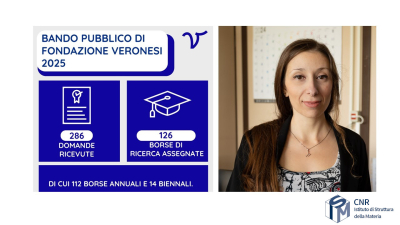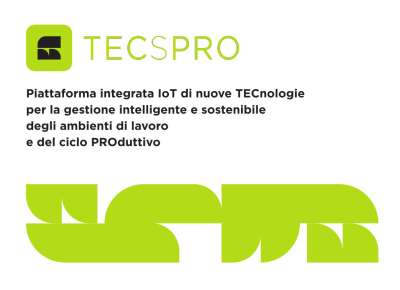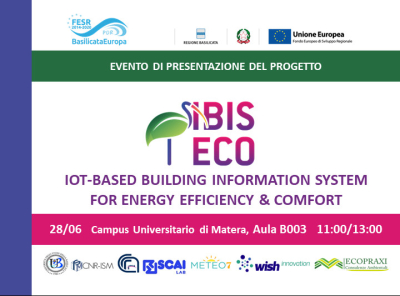Project
CNR-ISM involved in the RISEnergy infrastructural european project
The RISEnergy project offers industrial and academic researchers free transnational access to a selection of the best European and international facilities in various energy sectors, from photovoltaics to solar thermal energy and hydrogen, as well as materials research and information and communication technologies (ICT). The project supports research and innovation activities in these areas, ensuring access to its research facilities based on relevant criteria and a peer review process.
Cancer prevention by designing customized biosensors: cancer-related protein detection and clinical applications
Noemi Colozza was awarded with a two-year grant from the Umberto Veronesi Foundation aimed at developing a point-of-care sensor for the early diagnosis of the risk of uterine cancer development induced by human papillomavirus (HPV) infection
TECsPRO Project - Final Workshop
The TECsPRO project (Integrated IoT Platform of New Technologies for Smart and Sustainable Management of Work Environments and the Production Cycle) aims to develop a flexible IoT system for SMEs, promoting eco-friendly processes in line with the S3 Strategy. The project focuses on optimizing the use of IoT technologies in operational management and integrating devices and sensors for advanced analysis.
CNR-ISM contributes with studies on new materials to enhance collaboration between research and industry.
BLAZETEC European project
Formally started on July 1, 2024, the Horizon Europe project “BREAKTHROUGHS IN THERMAL BATTERIES THROUGH ZERO-EMISSION HIGH-TEMPERATURE STATIC THERMAL-TO-ELECTRIC CONVERTERS” - BLAZETEC was officially launched with the Kick-off Meeting held in Rome-Montelibretti on July 4-5, 2024.
APhRICA - "Advanced Physics in Rwanda Ism-cnr Cooperation Agreement"
Approved on June 25, 2024, by the CNR Board of Directors, the agreement with ICTP-EAIFR in Kigali (Rwanda) will launch multi-year strategic initiatives focused on advanced training and the exchange of experiences and scientific results in the fields of physics and materials science.
This project achieves a significant objective of the CNR's Reorganization and Relaunch Plan for the international repositioning of the Institution, which aims to initiate or strengthen strategic partnerships with research systems outside the EU.
IBIS ECO: Final Event for the Presentation of Project Results
On June 28th, the University Campus of Matera will host the presentation event for the results of the IBIS ECO project, aiming to inform system users and interested operators about the potential of the developed platform.
In particular, CNR-ISM will showcase the developed KET technology, with the release of the KET prototype installed in the demonstrators.
GREEN DIADEMA “GREEN DIAmond DEtector production MAchine”
A project born from the collaboration between OMICA Srl and the DiaTHEMA Lab of CNR-ISM. The goal is to create a green and smart system for the production of multispectral electro-optical diamond devices to be used for the detection of ultraviolet radiation, below 300 nm and at very low intensity, in a space environment. These devices can be utilized both for Earth observation and space missions.
ResET - Resonant Energy Transfer from Plasmonic Nanoparticles to Semiconductors: a Route to Improve Solar Photocatalytic Efficiency
ResET is a 2-year long project funded by the European Union - Next Generation EU through the PRIN PNRR2022 grant scheme.
It aims to investigate resonant transfer of energy from plasmonic materials to semiconductor materials as a route to sensitise these materials to light with energies both above and below their band gaps.
GIANCE - Graphene Alliance for Sustainable Multifunctional Materials to Tackle Environmental Challenges
GIANCE is a 3-year long project funded by Horizon Europe. It presents creative solutions to environmental challenges by establishing a comprehensive and industry-driven platform. This platform aims to design, develop, and produce the next generation of affordable, eco-friendly, lightweight, recyclable graphene and related materials(GRM)-based multifunctional composites, coatings, foams, and membranes.
SPEEDHY - Solar PhotoElectrochEmical black Diamond converters for hydrogen and ammonia production
SPEEDHY (Solar PhotoElectrochEmical black Diamond converters for hydrogen and ammonia production) project, funded within the PE5 sector of the PRIN 2022-U40 initiative, aims at demonstrating a new technology, based on defect engineerewww.speedhy.itd diamond structures, for the green production of hydrogen (H2) and ammonia (NH3) by exploiting concentrated solar radiation.
More...
ESILARANTE - ElectroSpray Immobilization of LAccase foR cANnabinoids deTEction
ESILARANTE is a project financed by the MUR as part of the PRIN 2022 call and aims to characterize and develop a portable sensor platform for the detection of tetrahydrocannabinol (THC), based on laccase-based biosensors produced through the green ElettroSpray Deposition technique ( ESD).
An idea born from the collaboration of the CNR - ISM Istituto di Struttura della Materia and the Alma Mater Studiorum - University of Bologna
NEST - Network for Energy Sustainable Transition
Universities, research centers, and businesses for the Italian Energy Transition.
The NEST Foundation is the core organization and sole point of reference for the implementation, coordination, and management of the "Extended Partnership" in the field of "Future Energy Scenarios, line 2a: Future Green Energies".
Effective Light management in 2D perOvskite absorbeRs for A disruptive tanDem phOtovoltaic technology - ELDORADO
ELDORADO is a project funded by the Italian Ministry of Education, Universities, and Research (MUR) under the PRIN 2022 call. The goal is to develop a new 2D perovskite active layer for use in a solar cell and optimize its integration into a tandem device to increase the energy conversion efficiency of a commercial silicon-based cell.
ATYPICAL - Atomically precise multifunctional single atom platforms
The goal of the project is to create single atom platforms, using organic templates obtained via the on-surface synthesis method. The focus is on 1D and 2D nanostructures with innovative characteristics and able to stabilize single metal atoms for applications in catalysis and magnetism.















 English (UK)
English (UK)  Italiano (Italia)
Italiano (Italia)